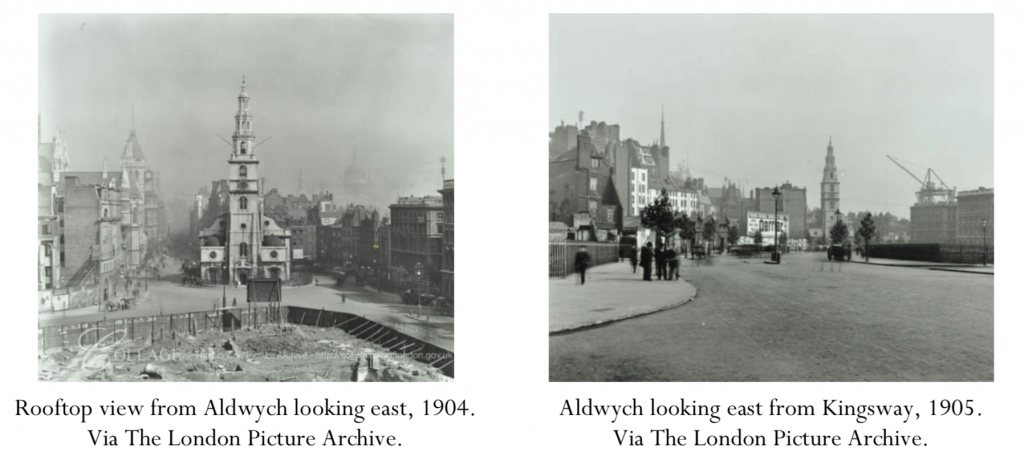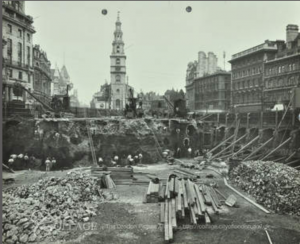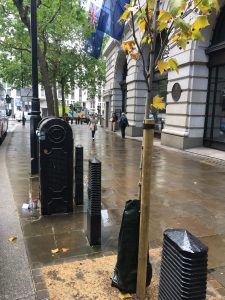Greening Aldwych Stop 4: Australia House (and a brief history of… poo)
From St Clement Danes, use the traffic lights to cross Aldwych, and head toward Australia House. Once outside Australia House, go right. You're now on the curve of Aldwych. You will see a tree that is much smaller than all the others. Stop here.
Or, click here to go back to Stop 3: Unexpected blooms - wildflowers and monuments.
By Clare Brant
 Demolition for Kingsway began in 1902, with the main thoroughfares officially opened in 1905. But it wasn't until 24 July 1913 that King George V laid the foundation stone for Australia House.
Demolition for Kingsway began in 1902, with the main thoroughfares officially opened in 1905. But it wasn't until 24 July 1913 that King George V laid the foundation stone for Australia House.
You can see in the photographs above the huge vacant lot opposite St Clements (see more images on the London Picture Archive).

St Clement Danes, from the Australia House site, 1912. London Picture Archive, Catalogue No. SC_PHL_01_437_4605c
The site was vacant so long after the big demolition that nature took over: it was described by The Daily Graphic as "a garden of wild flowers in the heart of London […] this rustic spot in urban surroundings."
The Australia High Commission reports that King George was accompanied by the Queen and Princess Mary to lay the stone. Apparently, "much was made of the enthusiastic shouts of “Coo-ee” from the predominantly Australian crowd at the end of the ceremony. The Daily Express reported 'it started suddenly and drew into a long-drawn, plaintive cry, which swelled and died again and again, coming to Londoner’s ears with almost startling novelty'."
Although building started in 1913, it was interrupted by war. Most of the building materials were imported from Australia - see Eileen Chanin’s glorious book Capital Designs: Australia House and Visions of an Imperial London (2018) for more.
Away from the grandure...
Neither building nor site, the pavement on the north side of Australia House holds a surprise: a hippo.

A small tree outside Australia House, London History Day, 30 May 2019.
Alongside the remnants of an eighteenth-century system of marking off by posts the pedestrian edge to a road, are familiar London plane trees. One is young enough to warrant a guard. Usually young trees are protected from animals (and people) by some sort of wooden enclosure of rails and posts.
But this tree has a fancy sleeve covering, officially termed a hippo. It’s plastic and Made in China. The protection seems to be at (roughly) dog level, and a possible biological threat from dogs relieving themselves.
Dog poo has a rich and fascinating history, especially in London. Excrement known as ‘pure’ was rubbed into hides, after a salt wash, then a urine wash. It made the skin flexible, and ready for soaking in solutions of tannin. In a horse-powered world there was demand for tack and harness, so dog poo became a useful commodity.
Henry Mayhew reports in London Labour and the London Poor (1851) that pure-finders (yes, an official job description) were struggling because of competition. There were then around 30 tanneries in London, centred in Bermondsey. You could live for a day on the proceeds of a bucket:
"The pure-finders meet with a ready market for all the dogs’-dung they are able to collect, at the numerous tanyards in Bermondsey, where they sell it by the stable-bucket full, and get from 8d. To 10d. per bucket, and sometimes 1s. and 1s. 2.d. for it, according to the quality."
Disappearance of horses from London made dog poo more visible, and attitudes changed. In the 1920s, bylaws were introduced that made not removing deposits a fineable offence. As Alex Parsons explains:
A criminal offence was created with the Dogs (Fouling of Land) Act 1996. This was taken further by the Clean Neighbourhoods and Environment Act 2005 with Dog Control Orders and these are in turn becoming Public Spaces Protection Orders via the Anti-Social Behaviour, Crime and Policing Act 2014.
So over 150 years dog poo goes from being a public good for private gain to being a public health hazard.
Opposite Australia House on the north side of Aldwych is a bar with an immaculate box trim outside. It is immaculate because it is plastic. Box in London has been subject to infestation by the box moth caterpillar: arriving in the UK in 2007, it has become established in the south east as a constant defoliator. ‘Life is an illusion’ says a neon sign in the bar: certainly its box is.
Directions to Stop 5: a Plane Tree paradise?
Walk west along Aldwych (St Clement Danes will be behind you). As you walk, notice how many trees line Aldwych today. Stop outside the main entrance to Bush House.
>>> Next Stop: a Plane Tree paradise?
<<< Return to Stop 3: Unexpected blooms - wildflowers and monuments
